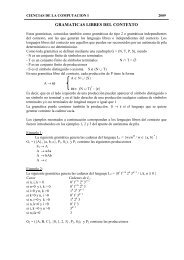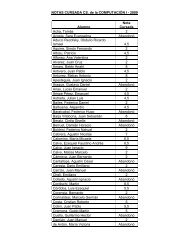Libro de Resúmenes / Book of Abstracts (Español/English)
Libro de Resúmenes / Book of Abstracts (Español/English)
Libro de Resúmenes / Book of Abstracts (Español/English)
Create successful ePaper yourself
Turn your PDF publications into a flip-book with our unique Google optimized e-Paper software.
Resumenes 56<br />
Syncronism in population networks with non linear coupling<br />
The goal <strong>of</strong> this work is to study the sincronism <strong>of</strong> populations<br />
coupled by <strong>de</strong>nsity-<strong>de</strong>pen<strong>de</strong>nt migration. We consi<strong>de</strong>r a metapopulation<br />
with n i<strong>de</strong>ntical patches with local dynamics (reproduction and survival)<br />
j<br />
j<br />
given by x t+<br />
1 = f ( xt<br />
) , where j<br />
x t is the number <strong>of</strong> individuals in patch j at<br />
time t. After the local dynamics stage, the migration process between<br />
patches takes place. We let ( )<br />
i<br />
µ xt<br />
be the fraction <strong>of</strong> individulas that leave<br />
patch i at time t, while ( )<br />
i<br />
c ji µ xt<br />
is the fraction <strong>of</strong> individuals leaving patch i<br />
and ariving at patch j. The dynamics <strong>of</strong> the population network is given by<br />
the system <strong>of</strong> n equations:<br />
x<br />
n<br />
j<br />
j j<br />
t + 1 = t t ∑<br />
i=<br />
1<br />
[ 1−<br />
µ ( f ( x ))] f ( x ) + c µ ( f ( x )) f ( x ) , j = 1,<br />
2,<br />
K,<br />
n .<br />
We study the stability <strong>of</strong> a syncronous orbit x t = xt<br />
for all<br />
j = 1, 2,<br />
K,<br />
n , where x t+<br />
1 = f ( xt<br />
) . These orbits lie on the diagonal <strong>of</strong> the<br />
phase space which is an invariant manifold in this case. Following the<br />
temporal evolution <strong>of</strong> a small transversal perturbation <strong>of</strong> an orbit in the<br />
invariant manifold (syncronous orbit), we can obtain conditions that<br />
garantee the stability <strong>of</strong> attractors in the invariant manifold (syncronous<br />
attractors). For typical orbits the stability condition is L Λ < 1 , where<br />
1<br />
L lim f ′ ( x ) K f ′ ( x ) f ′ ( x ) t<br />
ji<br />
= τ −1<br />
τ →∞<br />
is the Liapunov number and the quantifyer Λ is given by<br />
lim I ϕ ′ ) A)<br />
K ( I −ϕ<br />
′ ( x ) A)(<br />
I −ϕ<br />
′ ( x ) ,<br />
Λ = ( − ( xτ<br />
−1<br />
τ →∞<br />
where ϕ ( x ) = xµ<br />
( x)<br />
is the function that gives the number <strong>of</strong> individulas that<br />
migrate in each patch, A is a ( n −1) x(<br />
n −1)<br />
matrix obtained from the<br />
coefficients c ij and I is the ( n −1) x(<br />
n −1)<br />
i<strong>de</strong>ntity matrix. The analysis <strong>of</strong> the<br />
above expression allows us to conclu<strong>de</strong> that<br />
Λ ≤ lnσ<br />
( H ϕ x ) dρ(<br />
x)<br />
,<br />
exp ∫ −1<br />
′ ( )<br />
where H ϕ′ (x)<br />
is a nxn matrix with λ = 1 as an eigenvalue associated to the<br />
eigenvector [ ] T<br />
1 1 L 1 which is obtained from ϕ ′ and the coefficients c ij ,<br />
σ − 1( H ϕ′<br />
( x)<br />
) is the spectral radius <strong>of</strong> the matrix (x)<br />
i<br />
t<br />
1<br />
1<br />
i<br />
t<br />
0<br />
0<br />
1<br />
τ<br />
j<br />
H ϕ′ once the eigenvalue<br />
λ = 1 is removed, and ρ is the natural invariant measure. We show that in<br />
some special cases the above inequality is in fact an equality.



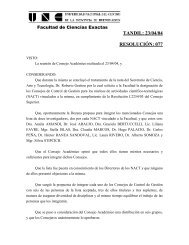
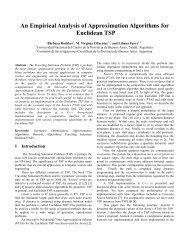




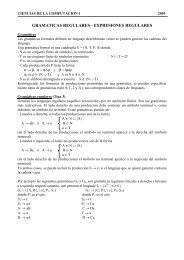

![Clase 13 [pdf]](https://img.yumpu.com/19616969/1/190x245/clase-13-pdf.jpg?quality=85)

